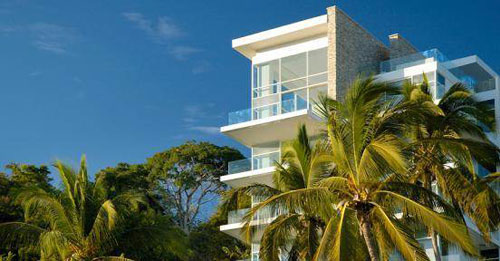Architectural Stone Veneers: Authentic and Appropriate Technology
Special Cases
Height Restrictions
With a surge of multifamily mixed-use projects, hotels and resorts with client design preference for a rustic, natural feel, there are many taller buildings clad in stone veneer. Designers should know that veneer attached to wood backing or sheathing is limited to 30 ft. above grade. For installation above 30 ft., consult with your local building code official or structural engineer regarding additional structural requirements.
 |
Photo courtesy of Eldorado Stone This multistoried hotel at the Bahlay Resort in Acapulco, Mexico, is clad with manufactured stone veneer. |
Expansion Joints
The placement of expansion joints adds one more layer of detail to any elevation or facade. Expansion joints allow movement in the facade, and these joints should not be spanned with stone veneer as this will lead to cracking. As part of preliminary design development, the architect will consult with an engineer on expansion joint requirements to enhance the design of the surface by careful placement of this key structural element.
According to a paper published in 2011 by the Masonry Institute, there does not seem to be a need for the installation of control joints based on aesthetic appearance alone in architectural veneer masonry construction. In comparison to stucco, this consultant concludes that it is unlikely that there will be water penetrating the lath behind the veneer. The “built-in” control joints (grout joints or dry stack stone joints) provide for expansion or contraction movement. Any cracking that may be experienced is accommodated across several grout joints, thereby allowing a distribution of the separation. Furthermore, each separation is virtually invisible, since these spaces occur at the stone-mortar interface. Where there are expansion joints in a building, “it is appropriate to install an expansion joint in the ACMV façade.”3
Vertical cracks in a stone surface may also occur because of improper lath preparation. Cracking may occur as the result of building settlement, wall deflection or improper installation. Use good design and building practices, and use a consulting engineer as necessary to verify structural requirements to prevent any failures in the stone veneer facade.
Rainscreens
Some building codes now require the use of a rainscreen drainage plane behind manufactured veneer. A wall system includes the interior surface, structural supports and a means to prevent moisture into the building while allowing water vapor to breath through the building skin. A rainscreen is the weather-resistant wall barrier that deters water intrusion into buildings. To prevent conditions that cause manufactured veneer to peel from a wall or contribute to the development of mold, some veneer systems may need the additional weather-resistant detailing that a rainscreen will provide. Consult with manufacturers’ installation requirements for installing stone veneer over rainscreen systems.
Appearance
Sealing stone veneer is not required, but it can provide added protection in harsh climates particularly where snow may accumulate throughout the winter. The design professional may specify a penetrating and breathable silane- or siloxane-based masonry sealer. These cement sealers may be used on the positive water pressure side of the wall. Consult the manufacturer for other sealant options. Some customers prefer the polished look of sealed stone.
One of the reasons to provide a breathable sealant is to avoid efflorescence on the wall surface. Efflorescence is a white residue that occasionally appears on a masonry surface caused from moisture moving through stone. The Masonry Institute defines efflorescence as the incrusted or covered surface from crystals of salt or the like through evaporation or chemical changes. A mixture of five parts water to one part white household vinegar can be used to clean and clear efflorescence from a wall surface. Do not use acids to clean stone veneer surfaces.
Spalling is the result of water entering the stone veneer surface and causing flaking, or peeling. Spalling can be prevented by using proper detailing particularly of top edge conditions such as the top of a wall that does not have a drip cap. Avoid excessive water absorption that can lead to the deterioration of stone by diverting water run-off. The proper detailing of cant strips, gutters and flashings will protect stone veneer from water damage.
Choosing a Good Supplier
Choosing a building material requires knowledge of the manufacturing process and supplier standards. When specifying manufactured stone veneer, the design professional should verify that the appropriate evaluation reports have been obtained and are available to review quality standards. There are three main evaluation services that provide third-party testing for stone veneer products. These evaluation reports are evidence that a product meets code requirements and warrants regulatory approval. The International Code Council Evaluation Services (ICC-ES), the National Evaluation Service, Inc. (NES) and Underwriters Laboratories (UL) provide reports on manufactured stone veneer. Some of the criteria tested by these services are the thermal resistance of the veneer as well as recommendations for mortar types.









